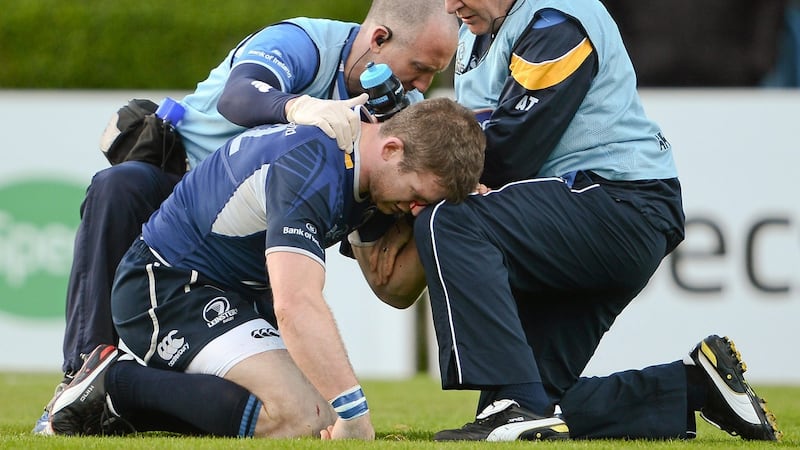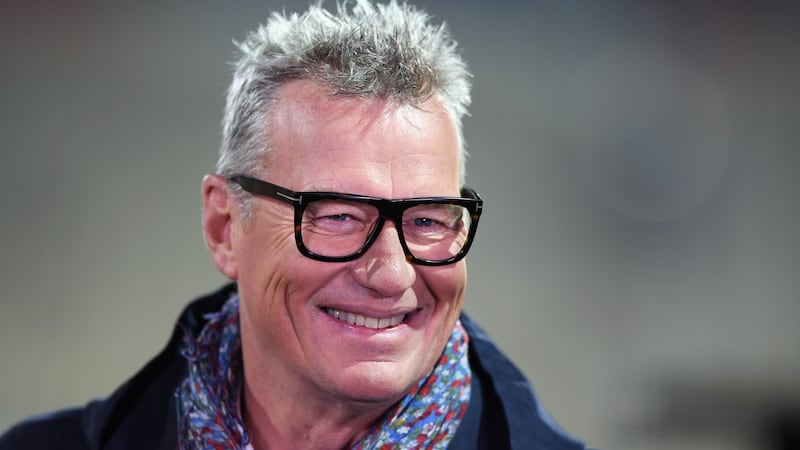I forgot my phone number recently and panicked. I doubt it was what I fear the most but a shiver went down my spine.
Eventually the 10 digits came back to me.
It is important to remember our concussion stories. Not as important as the technology that is needed to protect rugby players from traumatic brain injury (TBI).
In 2001 the Irish lads returning from the Lions tour of Australia kept going on about the English players’ physiques. They were enormous specimens. Second hand stuff about the Leicester Tigers tearing each other to shreds became first-hand accounts by Mal O’Kelly.
Mal spent that summer down under fighting Martin Johnson and Danny Grewcock mid-week - thankfully Jeremy Davidson had his back - so they were ready for whatever John Eales and Justin Harrison threw at them on the weekend.
Around this time Steve Thompson described the barbaric double training sessions for Northampton and in England camp.
I remember watching Leinster forwards trudge in from their second battering on a Tuesday evening. We – the backs – would be showered, dressed and getting on with our lives while our heavies would be in some state. Bloodied and bruised, not by choice but a necessity to prepare for Jonno’s Leicester because we now knew that was how they prepared to hurt us.
The brutality of rugby union in the early 2000s was best summed up by a drill Willie Anderson came up with called Murder Ball. There was no end game, no tries, no scoreboard either. Just two fully stacked XVs squeezed into a quarter of the pitch. The intention was to harden us up ahead of the weekend. Murder Ball struck a primal chord. It was about “sorting the men from boys” with the added threat of “you’ll get injured if you’re not going full bore.”
That was the culture when Steve Thompson, Alix Popham and Michael Lipman suffered the damage that has led to dementia at the age of 40.
Back then, nothing was more important than playing on after suffering a heavy blow. Nothing.
Thankfully I am not writing about myself. I was a winger during the period when rugby was knowingly or unknowingly failing to protect its players. The courts will decide which. Back then, Irish provinces played half the number of games as the English clubs so I like to think I avoided the sub-concussive blows that are chasing so many of my peers into retirement.
Only time will tell.
Worst charge
I have had four serious concussions. Four that I could not hide. Again, that was the culture; to say you were seeing stars or, worse, the black lights of unconsciousness, was to admit to being soft (and as Rassie Erasmus will learn during the 2023 World Cup pool stages, that is the worst charge that can be levelled at a rugby player).
My first serious blow to the head happened as a schoolboy playing for Clongowes. I was knocked out. They sat me down for three weeks. The others were quickly identified by the late Professor Arthur Tanner and Dr Éanna Falvey, a super-heavyweight national champion and the current chief medical officer for World Rugby.
I remember ‘The Prof’s’ words in 2012 as the blood flowed down my forehead and into my eyes: “Hang on Gordon while I check on Brad Thorn’s knee - it must be in terrible shape.”
‘Are you joking!?’
“Yes,” Arthur smiled. “Come on, let’s patch you up.”
A picture of this conversation is the only evidence of my rugby career on the walls of our home.

The last concussion happened against Australia in 2014. Yet again, I was stunned by friendly fire in a ruck. You never want to leave a Test match and as Dr Falvey eased me down the tunnel I protested: ‘Seriously Éanna, I am grand.’
“Let’s get you assessed so.”
He sat me down in the changing room and asked some basic questions that I could not answer.
“What about the assessment?” I protested but Éanna was already back on the touchline. I was concussed which meant I was disorientated which meant I wanted to play on.
The sensation caused by brain injury is similar to driving without full control of the wheel. Somebody else is steering as you try desperately to wrest back control. Only problem is you have forgotten where you are going.
Steve Thompson’s generation – my generation – were not protected enough to avoid early onset dementia and CTE. I do wonder what the future holds. I can only hope the changes made as professionalism evolved will be enough to avoid what is happening to Steve, Alix, Michael and others.
I wish someone yelled “stop” at Leinster training during the early 2000s. What we were doing was considered best practice when, in fact, those double sessions were insanity. We knew we were irrevocably damaging our bodies. We didn’t know it would lead to what Steve is experiencing. Not to our generation. Not so soon.
But here we are.
I presume the legal argument for the 70-plus compensation cases in the UK will focus on what the authorities did or did not do with the medical knowledge they possessed. Discovering how much information, if any, was hidden from the players will sway the overall judgement. Coaches and administrators will be called to answer tough questions. Their testimony will make for deeply unpleasant reading but this process can help to future proof our game.
If it even gets that far. In 2014 the NFL settled with its players for $1 billion because legal advice suggested a greater financial hit in court.
Rugby and science must focus on protecting the twenty-something hookers and “kamikaze” flankers (the nickname given to Tom Curry and Sam Underhill by their teammates). Otherwise, another ex-player will be struggling to write this same article in 2030.
We can save multiple lives by introducing preseason brain scans. Boxing, both amateur and professional, has been doing this for decades.
I would take issue with the argument of reducing contact in training. I hear what Dr Willie Stewart – a leading expert in TBI – is saying: in 2011 American Football brought in a once a week rule for “full contact padded practices.”
But this is not the hill rugby fights concussion on. The conditioning coaches have already crossed that bridge. The double sessions of a Tuesday were shelved by the 2010s. A spike in all sorts of injuries, increased games and education around concussion saw to that.
I struggle to see the value of further reducing body to body sessions and I’ll tell you why: tackling, being tackled, rucking and scrummaging are skills a player must constantly hone.
Essential preparation
Tackle technique was an essential part of my preparation for the Saturday afternoons that I man-marked Manu Tuilagi and Mathieu Bastareaud. I was giving up 20kg to these men. If I didn’t perform extra tackle drills on similarly shaped bodies not only would I become a speed bump, I would be putting myself in harm’s way with no muscle memory developed to avoid spilling my own blood on the grass.
I know the scientists will disagree but limited, specific contact sessions remain essential preparation.
Same goes for the work John Fogarty does with the Ireland scrum before locking horns with Mako Vunipola or the next gigantic frontrow that comes looking for Andrew Porter and Cian Healy.
I remember the match in Italy that effectively ended Fogarty’s career. And, for a period, changed his life. I remember him fumbling around for the ball before attempting a dive pass to Isa Nacewa that made him look like he was on the other team. We would laugh about it now if the consequences were not so frightening.
In the months that followed Fogs suffered, literally, in the dark. We still existed in a culture of silence. No rugby player wants to be seen as soft. So we got up and attempted to play on.
That was professional rugby in its first iteration. Thankfully that attitude was fading, the dinosaurs all but extinct, when I retired in 2015.
I do remember when the penny dropped. Every evening in Ireland camp the next day’s itinerary would be slid under the bedroom door. The next morning we gathered for a mandatory presentation by an independent doctor who explained how concussive impacts alter a person’s brain function. There was a video that showed Rob Kearney trying to get back to his feet and into the defensive line. Delayed neural pathways had Rob stumbling about like Charlie Chaplin. We would laugh about it now if the consequences were not so frightening.
The mood in the room was far from comical. Most people remembered another piece of paper that would be slid under our doors in previous years. All it said was: “Get In The Line.”
No matter what was wrong, you got up and made your tackle.
Our job was extremely dangerous. We knew this. Nobody was getting up and walking away from a six figure salary. Nobody was yelling “stop.” Not that it would have made any difference.
Zero tolerance needed for head shots
I hope John Kirwan continues to reflect on his recent words about abandoning the red card sanction for a head shot. The former All Black has a huge global reach and zero tolerance for this very act is one way the current generation can improve their chances of avoiding TBI, dementia and CTE.

If Dev Toner is able to dip down in the tackle – as he proved numerous times against Montpellier – then so can everyone else.
Concussion does not appear to be an immediate problem in the professional game. The game’s reliance on the Head Injury Assessment may eventually rubbish these words but, right now, it is the amateur player that needs additional protection.
Crucial to this is showing children how to give and receive contact. It is just as important as teaching a six-year-old to scoop the sliotar onto their hurley.
Grassroots coaching, to my mind, is rugby’s salvation.
But for the past few days I have barely considered the future of the game. Nor am I concerned as a father of three children, two of whom are already swinging away for Ranelagh Gaels. To be honest, what is happening to Steve Thompson has me worried about my own health because the damage has already been done.













